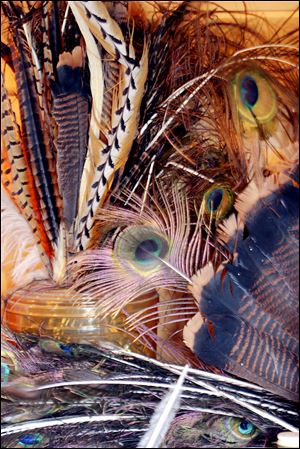
Fine-feathered trend raises hackles
7/3/2011
Feathers and animal hair that Dave Asproth uses to tie flys are almost everywhere in his home just outside of Grand Marais, Minnesota.
MINNEAPOLIS — When fashion and fly fishing cross paths, feathers may fly. Off the shelves, at least.
The long, skinny feathers favored by sportsmen come in an array of naturally rich colors, from cream to rusty brown, and patterns. Plucked from specially bred roosters, they are used to tie trophy trout-landing dry flies — and also happen to look really good when woven into hair as face-framing decorations, a trend that’s sweeping the country.
The trend has hit northwest Ohio as well. At the Beauty Bar on West Central Avenue, for example, feathers are available in a range of colors: blonde, orange, red, yellow, magenta, neon green, emerald green, blue, aqua, lavender, black, and purple. For $37, a customer gets a bundle of three small feathers and one large accent feather.
Women of all ages (and some men, like rocker Steven Tyler of Aerosmith) who are buying the ornaments don’t care that the feathers they covet would be described by a fisherman as prime quality size 16 saddle hackles in Barred Dark Ginger. They just like the look. Trouble is, so many people want them in their hair, supplies are now severely limited and prices jacked up.
Scott Struif, manager of the fly shop at Thorne Bros. Custom Rod & Tackle in Blaine, Minn., doesn’t like looking at the aisle of empty pegs where his feathers — called "hackle" in fishing parlance — should be. He hasn’t had a decent supply since February.
"When you’ve got teenage girls all over the country wanting them, demand seems like about 1,000 times the norm," he said. "But I’m hoping the trend runs its course soon. To us, if you’re going to tie a certain trout fly, you need two different colors of this very specific feather and if you don’t have it, story’s over."
Andy Roth of Prescott, Wis., a fishing guide and founder of the online business Gray Goat Fly Fishing, got early wind of the trend and blogged about it in February.
"Six months ago, when I heard reports of young ladies wandering into fly shops in groups, everyone laughed and thought it was a joke," he said. "Then the major hackle herders, the guys who have been working on chicken genetics since the ’70s to develop perfect feathers for fly tying, started getting contacted by major hair salons."
This spring isn’t the first time that nonsportsman types have been drawn to beautiful fishing supplies. In the 1980s at Bright Waters, a former fly shop in south Minneapolis, drag queens and strippers from the notorious Augie’s regularly came in to raid the feather stash.
But their numbers were too small to make a serious dent, unlike this year.
At the City Look salon in Minnetonka, Minn., stylists do 15 to 20 feather customers a week. Anna Mirkin, who just finished 10th grade at Maple Grove Senior High, recently went there with a group of friends, paying $10 to $30 to have feathers installed in their ’dos.
"My lacrosse coach had one, and now at least 75 girls in my school do," she said. "They just give your hair a little pop."
The feathers eventually fall out as hair grows, but can last up to two months. Some salons will reattach the same feathers for free.
Getting the feather look is quick — about 15 minutes — and relatively cheap, but rapidly getting more expensive. At Juut in downtown Minneapolis, each bundle of seven thin feathers has gone from $25 to $35. Thanks to girls who want to look like pop star Ke$ha, an early adopter of the feather look, there are also DIY tutorials on YouTube.
Note to the trendy-feathered: The birds your ornament came from were mighty pampered f owls. Each rooster gets his own little house, because if they fight, it ruins their feathers.
Also, someone (besides the chickens, which are killed for their pelts before the feathers can be used) may have suffered for your beauty. Colorado-based Tom Whiting, considered the best in the feather business, inspects every one of his birds while they’re still alive to continue fine-tuning the breeding.
"They peck and claw the heck out of him," Mr. Roth said.
The trend has even reached Minnesota’s North Shore. In Duluth, Great Lakes Fly Shop owner John Fehnel called it "the most ridiculous thing" he’s seen in his 11 years there. "Hopefully it’ll phase out in a month or so."
Mr. Roth, who seems to find the whole feather dust-up at least mildly amusing, has a more circumspect attitude.
"The old boys’ network didn’t think of it first, that’s what all the bellyaching is about," he said. "Those hackle herders have worked hard breeding these birds; they deserve to capitalize on this."
Like most fads, this one’s likely to level off, and may do so in time for new roosters to be raised and plucked for the next fishing season. Things could be worse, as one outdoorsman wrote on Mr. Roth’s blog:
"I’m just glad it’s feathers and not antlers."